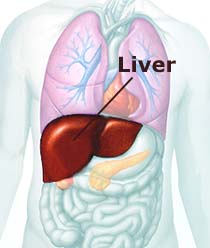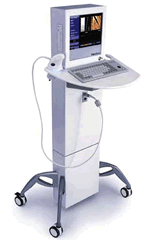Studies
Find No Evidence of Hepatitis C Virus Relapse or Significant Fibrosis after Spontaneous
Clearance in HIV-HCV Coinfected Individuals By
Liz Highleyman
 About
25% of individuals with hepatitis C virus (HCV)
monoinfection spontaneously clear the virus without treatment,
although some studies have reported continued low-level HCV replication in the
liver despite undetectable serum HCV RNA. About
25% of individuals with hepatitis C virus (HCV)
monoinfection spontaneously clear the virus without treatment,
although some studies have reported continued low-level HCV replication in the
liver despite undetectable serum HCV RNA.
Spontaneous
clearance is less likely to occur in HIV-HCV
coinfected people, but when it does, clearance is sustained over the long
term -- with a reduced risk of liver disease progression -- according to 2 studies
presented at the 44th Annual Meeting of the European Association
for the Study of the Liver (EASL 2009) last month in Copenhagen.
Long-term
HCV Clearance
In
the first study, P. Barreiro and colleagues from Hospital Carlos III in Madrid,
Spain, evaluated 827 HIV positive individuals with antibodies against HCV; the
patients had never been treated with interferon-based
therapy for hepatitis C.
Within this coinfected cohort, 174 patients
had undetectable serum HCV RNA. Of these, 42 had elevated liver enzymes (ALT,
AST), which could be attributed to heavy alcohol use in 26 cases and steatosis
in 10 cases, but had no known cause in 6 cases. Individuals with detectable hepatitis
B virus (HBV) surface antigen (HBsAg) were excluded.
This left 132
HCV antibody positive but HCV RNA negative patients to be included in the present
analysis. About 80% were men, the mean age was 38 years, and 84% had a history
of injection drug use. Most (82%) were on HAART
and the mean CD4 cell count was 421 cells/mm3.
 Repeated
serum HCV RNA testing (median 3 times per person) over a median follow-up period
of 3 years did not reveal a single positive result using a real-time PCR assay
with a lower limit of detection of 10 IU/mL. Furthermore, participants had absent
or mild liver fibrosis
as estimated using transient elastometry (FibroScan), with a mean value of 5.41
kPa and a median of 4.90 kPa. Only 1 patient had moderate (Metavir stage F2) fibrosis. Repeated
serum HCV RNA testing (median 3 times per person) over a median follow-up period
of 3 years did not reveal a single positive result using a real-time PCR assay
with a lower limit of detection of 10 IU/mL. Furthermore, participants had absent
or mild liver fibrosis
as estimated using transient elastometry (FibroScan), with a mean value of 5.41
kPa and a median of 4.90 kPa. Only 1 patient had moderate (Metavir stage F2) fibrosis.
"There
is no evidence for low-level HCV replication [or] for significant hepatic fibrosis"
in HIV positive individuals who have spontaneously cleared HCV infection, the
investigators concluded. "This information strongly suggests that HCV eradication
has occurred in this subset of patients."
Hospital Carlos III,
Madrid, Spain
HCV
Reappearance
In
a related study, L. Peters from the University of Copenhagen and an international
team of colleagues followed 256 HIV positive patients in the large EuroSIDA cohort
who were previously
shown to have spontaneously cleared HCV infection (23% of the 1940 HCV antibody
positive patients in the cohort).
 All
HIV positive patients with prior spontaneous HCV clearance and at least 1 subsequent
follow-up plasma sample were analyzed. The final sample was tested for HCV RNA
using the Roche Cobas TaqMan assay. All
HIV positive patients with prior spontaneous HCV clearance and at least 1 subsequent
follow-up plasma sample were analyzed. The final sample was tested for HCV RNA
using the Roche Cobas TaqMan assay.
Individuals with HCV RNA > 615
IU/mL were defined as having HCV "reappearance." These patients were
compared with those who still had undetectable HCV viral load. Logistic regression
was used to identify factors associated with HCV reappearance.
Of the 256
patients included in the analysis, 46 (18%) showed evidence of HCV reappearance
-- with a median HCV RNA level of 462,500 IU/mL -- over a median follow-up period
of about 3 years. Compared to patients who remained HCV RNA negative, those who
experienced HCV reappearance were significantly more likely to be injection
drug users (80% vs 58%), but significantly less likely to be HBsAg positive
(2% vs 15%).
The researchers concluded that reinfection due to repeated
exposure to HCV, primarily among injection drug users, was the most likely explanation
for these findings, rather than HCV relapse due to HIV-associated immunosuppression.
Furthermore, these results support previous research indicating that HCV and HBV
inhibit one another, and the presence of HBV provides some protection against
HCV infection.
Copenhagen HIV Programme - University of Copenhagen,
Copenhagen, Denmark; University College Medical School, Royal Free Campus, London,
UK; Hospital Carlos III, Madrid, Spai; University of Bonn, Bonn, Germany; Centre
for Viral Disease/KMA, Copenhagen University Hospital, Rigshospitalet, Copenhagen,
Denmark; Academisch Ziekenhuis bij de Universiteit van Amsterdam, Amsterdam, Netherlands;
Hopital de la Pitié-Salpêtriére, Paris, France; St Petersburg
AIDS Centre, St. Petersburg, Russia; Medical University of Bialystok, Bialystok,
Poland.
5/19/09 References
P
Barreiro, E Vispo, P Tuma, and others. No Evidence for Low-Level HCV Replication
or Significant Liver Fibrosis in HIV Patients Who Spontaneously Cleared HCV Infection.
44th Annual Meeting of the European Association for the Study of the Liver (EASL
2009). Copenhagen, Denmark. April 22-26, 2009.
L Peters, A Mocroft, V.
Soriano, and others. Hepatitis C Virus Reappearance in HIV-Infected Patients with
Spontaneous HCV-RNA Clearance. EASL 2009. Copenhagen, Denmark. April 22-26, 2009.
EASL
2009 MAIN PAGE

15th
Conference on Retroviruses and Opportunistic Infections (CROI 2009)
Coverage
by HIV and Hepatitis.com - February 8 - 11, 2009, Montreal
HIV and AIDS Treatment
News, Experimental News, FDA-approved News Highlights
of the 15th Conference on Retroviruses and Opportunistic Infections (CROI 2009)
- Coverage by HIV and Hepatitis.com, February 8 - 11, 2009, Montreal
|
|